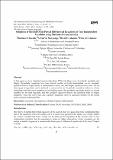| dc.contributor.author | Boniface Otieno Kwach, Alfred W Manyonge, David Olambo, Titus JO Aminer | |
| dc.date.accessioned | 2020-08-05T08:17:43Z | |
| dc.date.available | 2020-08-05T08:17:43Z | |
| dc.date.issued | 2013-06-01 | |
| dc.identifier.uri | https://repository.maseno.ac.ke/handle/123456789/1822 | |
| dc.description.abstract | In this paper we have classified second order linear PDEs into three types, hyperbolic, parabolic and elliptic. Hyperbolic equations have two distinct families of (real) characteristic curves, parabolic equations have a single family of characteristic curves, and the elliptic equations have none. All the three types of equations can be reduced to canonical forms. Hyperbolic equations reduce to a form coinciding with the wave equation in the leading terms, the parabolic equations reduce to a form modeled by the heat equation, and the Laplace’s equation models the canonical form of elliptic equations. Thus, the wave, heat and Laplace’s equations serve as canonical models for all second order constant coefficient PDEs. | en_US |
| dc.publisher | nternational Journal of Engineering and Mathematical Sciences | en_US |
| dc.subject | Canonical, Characteristics, Models, Partially differentiable | en_US |
| dc.title | Solutions of second-order partial differential equations in two independent variables using method of characteristics | en_US |
| dc.type | Article | en_US |

